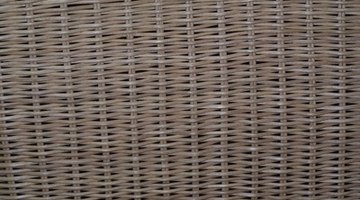How Do I Upholster a Wicker Trunk?
Wicker trunks are useful pieces of storage furniture, but they can be expensive to replace. Wicker trunks are usually made of tight rattan woven over a wood frame and interior. Wicker trunks can be upholstered over the aging or damaged wicker with fabric or leather. Save hundreds of dollars by upholstering the wicker trunk yourself instead of seeking professional assistance. You can upholster your trunk in a matter of hours.
Upholstering the Exterior of a Wicker Trunk

-
Measure the trunk's height from the front center inside edge of the frame to the front center bottom exterior edge. Add 2 inches to this measurement for the modified height measurement.
-
Place the tape measure end at the trunk's back center. Measure, horizontally, around the left side, across the front, around the right side, and across the back until the tape meets the tape end. This is the modified length measurement. You will be cutting one long rectangle that will wrap around the exterior of the trunk.
-
Cut one rectangle of batting and one rectangle of upholstery (or fabric) according to the modified height and width measurments. The rectangle of batting will wrap around the exterior of the trunk. The rectangle of upholstery will wrap around the batting around the exterior of the trunk.
-
Center one of the short ends of the batting on the outside of the trunk's back center. Use a glue gun to glue the batting end, vertically, to the trunk.
-
Stretch the batting over the trunk's back left corner frame. Hold the batting taut. Staple the batting to the wood. Pull the batting toward the front left corner frame. Staple. Continue stretching batting across the trunk's corner frames and stapling. Glue the batting end to the trunk.
-
Align the top edge of the batting with the top edge of the trunk, where it opens. Pull the top edge of the rectangle of batting over the top of the frame onto the interior edge by about 1 inch and staple. Turn the trunk over. Stretch the bottom edge of the rectangle of batting to the bottom frame and staple, to secure the top/bottom edge of the batting to the trunk. Turn the trunk over so the lid is on top.
-
Repeat steps 4 through 6 to apply the fabric over the batting. Trim the fabric/batting by cutting the excess materials straight on top of the interior edge of the trunk. This will be covered up by the trunk's lid.
-
Staple the braid vertically over the four frame corners. Staple braid along the top and bottom edges over the fabric onto the frame. Gimp braid will camouflage the staples.
Upholstering the Wicker Trunk Lid
-
Open the lid. Measure the lid's width. You are determining the size of the rectangle of fabric and batting you need to cut to cover the trunk's lid.
-
Measure the depth of the lid. Multiply the depth of the lid by 2. You are multiplying the depth measurement in order to allow extra fabric for the front and back of the lid. This is the adjusted depth measurement.
-
Add the adjusted depth measurement to the width measurement. Add 2 inches to this measurement. This is the modified width measurement.
-
Measure the lid's length and add it to the adjusted depth measurement. Add 2 inches to this measurement. This is the modified length measurement.
-
Cut rectangles of batting and upholstery according to the modified width and modified length. The rectangles of batting and fabric will cover the lid.
-
Lay the batting on top of the lid. Pull the batting under the back lid edge and staple it inside on the frame. Stretch the batting over the top of the lid and staple it under the front lid edge on top of the interior frame. If you're working on an attached lid, cut slits on the batting over the trunk hinges, so the batting will lay flat. Repeat for the lid's right and left sides, tucking the corners, which will form a triangle shape, under the batting before you staple. If you can't get the batting to fold over the corners, trim the excess away near the frame corners, and staple the opening closed.
-
Cover the batting with the upholstery in the same way you applied the batting. Since the staples are inside, they won't show. If working on an attached lid, cut small slits through the fabric over the trunk's hinges so the fabric will lay flat. Fold the raw edges of the slits inside about 1/4 inch and glue.
-
Staple braid along the lid's exterior edge for decoration if desired. Trim the fabric/batting inside so it is even by cutting along the top of the interior frame edge.
References
Tips
- Braid can be stapled inside of the trunk to cover the raw edges of fabric/batting if desired.
Warnings
- Use caution with staple guns. Wood staples are very sharp.
Writer Bio
Louise Harding holds a B.A. in English language arts and is a licensed teacher. Harding is a professional fiction writer. She is mother to four children, two adopted internationally, and has had small businesses involving sewing and crafting for children and the home. Harding's frugal domestic skills help readers save money around the home.
Photo Credits
- Wicker image by Gary Chorpenning from Fotolia.com
More Articles



